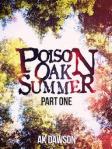 ‘Though mid July, the air blowing off Mount Hood still tasted like snow, and there was a restless humidity lurking underneath, as if summer circled the streets of Portland like a restless cat looking for a sunbeam in which to settle.’
‘Though mid July, the air blowing off Mount Hood still tasted like snow, and there was a restless humidity lurking underneath, as if summer circled the streets of Portland like a restless cat looking for a sunbeam in which to settle.’
This is the second sentence of Keith Edwards’ ‘The Lives of Perfect Creatures’, and is exactly the kind of reassurance you need to find quickly in a self-published book that the writer knows how to write. It was especially welcome as the first sentence described the main character ‘peddling’ her bicycle around town, leaving me uncertain if this was an American spelling, a typo for ‘pedalling’, or if she was actually trying to sell her bicycle!
I was attracted to ‘The Lives of Perfect Creatures’ because it’s set in Oregon, in the Pacific Northwest of the USA, and I spent a year living there back in the 1980s. It’s a part of the States with its own unique vibe, and this book captures the individualistic kookiness of some of its inhabitants perfectly. I met all kinds of eccentrics in my own time there. It’s as if all the weird people just kept heading west until they got to the sea, and then they had to settle down together.
Although this oddball book has got its share of imperfections that would probably forever exclude it from the lists of conventional publishers, it’s also got a lot of quirky charm and it doesn’t linger too long on the palate, so it’s well worth a quick read.
We are introduced to two main characters, young women called Sophie and Astrid, librarians at the Sacagawea Library and Reading Room, whose display of taxidermy includes ‘a cobra coiled around a pile of encyclopedias rearing back, ready to strike a mongoose that was defending himself with a copy of Walt Whitman’s Leaves of Grass’. Other denizens of the library include ‘the three crones who resided in the Reference Office’ who had ‘long been suspected of answering reference questions by rolling the bones, reading entrails or consulting tomes arcane, malignant, and not at all sanctioned by the American Library Association.’
Sophie and Astrid entertain themselves with strange accoutrements and surreal conversation, and their speculations on Sophie’s encounter with a mysterious moustached man is the starting point of the book’s storyline. Together with a third character, Sophie’s ex-boyfriend Sam Flanges (‘Even as a child, his perpetually disheveled hair and slightly silly grin made him look as if he’d been gulping cough syrup’) they set off on the trail of this enigmatic stranger, whose umbrella is in Sophie’s possession.
The task is made harder by Portland’s status as ‘the city with the most facial hair in North America. Everywhere she went, she was indundated by men sporting Chinstraps, Captain Jacks, Door Knockers, Lamb Chops, Soupstrainers, Imperials, Mutton Chops, Soul Patches, Facespanners, Pencils, Royals, Pancho Villas, Van Dycks… She stopped at the House of Louie for dim sum, and found every waiter sporting a Wing Chow.’
After a while, Sophie does meet her man – he is recovering on a park bench after being beaten up by a gang of clergymen over ‘theological disagreements’. His name is Jonah Peach, and he knows a certain Claude Aster – which is also the fictitious name Astrid sometimes gives herself. Sophie and Jonah discuss aliens, and seem to get along well.
That night, Sophie is visited by Yuri Gagarin, the astronaut. Now the book starts to fill up with other strange characters. One of them, Pyotr Rabbit, ‘a Russian mystic’ and frustrated wannabee astronaut, offers what is perhaps a clue to how to take the whole book in a random conversation with Sophie:
‘So, you’re saying I should take lots of drugs, then this will all make sense?’ she says.
He replies:
‘Not saying yes, not saying no. Just saying have an open mind. Many things fight for attention. Some are important, others not as much.’
Well, next thing is Sophie gets kidnapped by three men with mustaches (‘They took Sophie by the arm in the trained, solid grip of men who were used to restraining people for fun and profit.’) and questioned by a man calling himself Claude Aster. They want Jonah’s umbrella, but Sophie no longer has it.
I could go on, but to be frank, by the time I was half way through the book, the plot had vanished into irrelevance for me. The latter part of the book features alien invasion theories, robots, and a good deal of running about and fighting. However, what actually kept me reading were the charmingly tangential conversations that the characters kept having, and the sharply observed descriptions of people, clothing, houses and rooms that actually had more to do with real life than the wild fantasy of the plot.
So, in conclusion, in my opinion this book is well worth a read for its Oregonian whimsicality, witty jokes, and passages of fine descriptive writing, but don’t expect to care too much about what actually happens!
Reviewed by Robert Dodds
Available in Kindle format
Find out more about Keith Edwards











